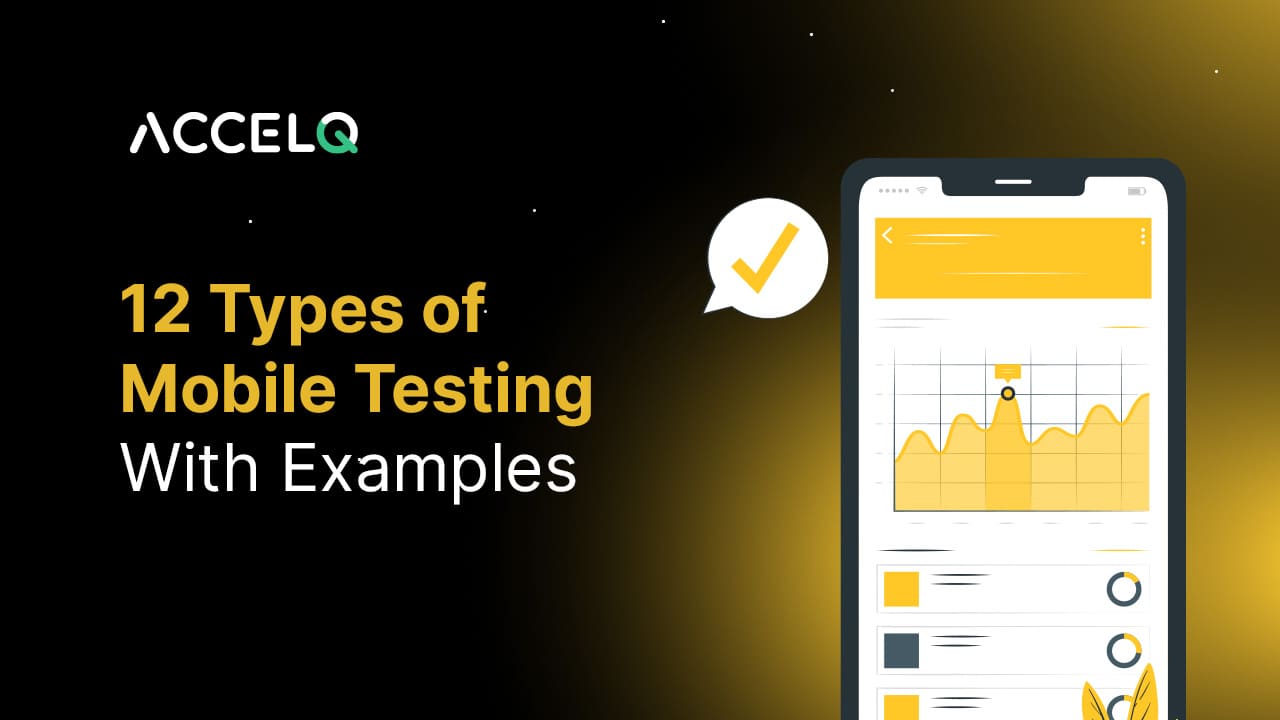12 Types of Mobile Testing With Examples

Mobile apps continue to take place in our daily lives. Today, every 8 out of 10 organizations launch their mobile applications, making their reliability and performance crucial. But for many billions of mobile apps to operate correctly and provide a seamless user experience, testing them across different parameters is important.
Is it possible to test a mobile application thoroughly? As there are mobiles with different models, dimensions, operating systems, etc. Upon all that how to test the mobile hardware itself? Hence, this implies the importance of different types of mobile testing.
SUGGESTED READ - What is Mobile testing? The perfect approach
12 Types of Mobile Testing
Functional Testing:
Functional Testing in mobile app development rigorously evaluates each function for its intended performance. This testing dives into the app's features, ensuring they operate correctly under different scenarios.
- Objective: Examine specific functions like user registration and feature utilization.
- Process: Create and execute test scenarios, then evaluate the outcomes.
- Example: Consider a banking app – functional testing checks everything from login to fund transfers, ensuring reliability at every step.
Usability Testing:
Usability testing prioritizes the user experience altogether. It's all about making the app intuitive, engaging, and easy to navigate.
- Objective: Assess the app’s ease of use and accessibility.
- Process: Watch real users interact with the app and collect their feedback.
- Example: Take a banking app – usability testing ensures that even a first-time user can navigate through loan applications or account management effortlessly.
Compatibility Testing:
Compatibility Testing ensures the app delivers a consistent experience across various devices and operating systems.
- Objective: Guarantee smooth functioning on different devices and OS versions.
- Process: Test the app across a spectrum of devices and systems.
- Example: Banking app must work flawlessly on an old Android device or the latest iPhone model.
Performance Testing:
Performance Testing is about the app's ability to handle stress, be it high user traffic or intensive data processing. It ensures the app remains swift and stable under pressure.
- Objective: Evaluate responsiveness and stability.
- Process: Simulate scenarios of high user traffic and data processing.
- Example: Having payday traffic on your banking app – performance testing ensures it can handle the surge without a hitch.
Security Testing:
Security Testing is critical, especially for apps handling sensitive data. It's about building a digital fortress to protect user information.
- Objective: Identify and fix security vulnerabilities.
- Process: Conduct comprehensive security checks.
- Example: In a banking app, security testing ensures that personal and financial information is ironclad against breaches.
Installation Testing:
Installation Testing focuses on the user's first interaction with the app, beginning with its installation, update, and uninstallation processes. It's about making great first impressions and lasting reliability.
- Objective: Ensure smooth installation and updates.
- Process: Test under various conditions, like interrupted updates.
- Example: Updating a banking app mid-transaction? Installation testing ensures no hiccups.
Localization Testing:
Localization Testing ensures the app resonates with users worldwide, adapting to their language, culture, and preferences.
- Objective: Customize the app for different regions.
- Process: Adapt and test elements like language and content.
- Example: A user in Japan finds everything they need in Japanese on the banking app, thanks to localization testing.
Exploratory Testing:
Exploratory Testing is where testers creativity shines, as they interact with the app in unscripted, innovative ways to uncover hidden issues.
- Objective: Find bugs and usability issues through creative testing.
- Process: Encourage testers to think out of the box.
- Example: A tester playing with transaction sequences in the banking app might discover unexpected bugs.
Interruption Testing:
Interruption Testing ensures the app can handle unexpected calls or notifications without losing its stride.
- Objective: Test app behavior during interruptions.
- Process: Simulate various disruptions.
- Example: A call during a fund transfer in a banking app? Interruption testing ensures the process resumes smoothly post-call.
Memory Leak Testing:
Memory Leak Testing is all about efficiency, ensuring the app doesn't consume more memory than necessary, which could lead to crashes.
- Objective: Identify and resolve memory leaks.
- Process: Monitor and analyze memory usage.
- Example: A banking app stays lean and efficient, even during prolonged use, thanks to memory leak testing.
Recovery Testing:
Recovery Testing checks the app's ability to recover from crashes or errors gracefully, preserving user data and functionality.
- Objective: Ensure effective recovery from failures.
- Process: Test response to various failure scenarios.
- Example: If the banking app crashes, recovery testing ensures it restarts smoothly, keeping the user’s data and session intact.
Bluetooth and Wi-Fi Testing:
Bluetooth and Wi-Fi Testing assesses the app's performance over wireless connections, crucial for apps dependent on network connectivity.
- Objective: Test functionality over wireless networks.
- Process: Evaluate performance on Bluetooth and Wi-Fi.
- Example: Syncing data over Wi-Fi or Bluetooth in the banking app? This testing ensures stable, accurate connectivity.
Conclusion
In summary, the range of mobile testing types is integral to developing successful mobile applications. Beginning from functionality to Bluetooth and Wi-Fi testing helps ensure the app is functional, user-friendly, and secure. By having these testing methods, developers and testers can have multiple apps running through the demands after thorough testing.
ACCELQ can enhance your mobile testing into a quick and perfect testing strategy with automated and no code testing.
Suma Ganji
Senior Content Writer
Expertly navigating technical and UX writing, she crafts captivating content that hits the mark every time. With a keen SEO understanding, her work consistently resonates with readers while securing prime online visibility. When the day's work ends, you'll find her immersed in literary escapades in her quaint book house.
Discover More
 Test Automation in Financial Services With ACCELQ
Test Automation in Financial Services With ACCELQ
Test Automation in Financial Services With ACCELQ
 What is Azure DevOps and how is it used? Why automate Azure DevOps?
What is Azure DevOps and how is it used? Why automate Azure DevOps?
































